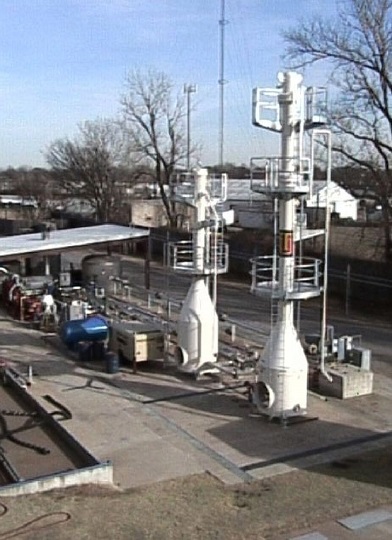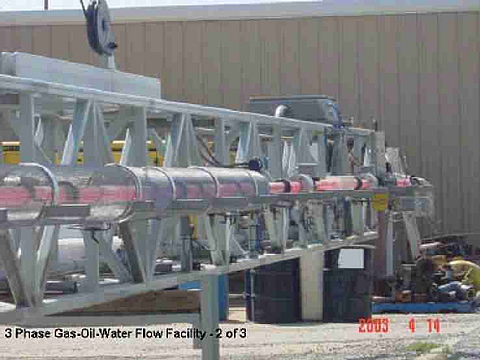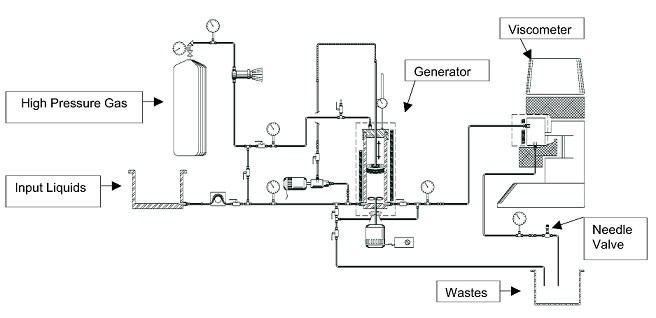Declining U. S. oil production and more stringent environmental regulations have resulted in a search for improved technologies to reduce costs and improve recovery from existing hydrocarbon reserves. Drilling operations is one of the most important areas for cost reductions in hydrocarbon exploration and development activities, particularly in the drilling of directional, horizontal and multilateral wells. Since many reservoirs in the lower 48 states are partially depleted or have low reservoir pressure, this has led to the use of aerated or compressible drilling fluids to minimize drilling fluid invasion and formation damage. Underbalanced or low-head drilling technology improvements may well have strategic importance is satisfying domestic and world demand for oil and natural gas. Additionally, offshore and frontier drilling at depths requires specialized, environmentally friendly, but costly, drilling fluids that are effective at elevated temperatures and pressures.
Cuttings must be removed from a well as it is drilled. This is done by pumping a drilling fluid down through the drillstring and the drill bit and then pumping the mixture back to the surface through the space between the drillstring and the wellbore. The goal is to continuously move cuttings from the wellbore to the surface and maintain a clean wellbore as drilling progresses. When inadequate wellbore cleaning occurs, the drillstring can become stuck. The resulting remedial operations to free the drillstring and restart the drilling can increase the costs significantly, especially for off-shore rigs where day rates can be as high as $400,000 a day.
Project Results
The unique Advanced Cuttings Transport Facility (ACTF) constructed at the University of Tulsa campus is funded by DOE and a Joint Industry Partnership (JIP) to study the complex problems related to production fluids and removal of rock chips or cuttings generated by drilling. The objectives of the ACTF are to advance drilling technology, reduce costs, and improve well production.
The study has shown that different drilling fluid properties have different capacities to transport cuttings and move them out of the wellbore. Foams have been discovered to be a optimal transport fluid. To facilitate research a Foam Generator/
Viscometer has been developed, which can operate under the required downhole conditions to make foam. This generator is being patented by Temco, Inc. a partner in the JIP with the University of Tulsa.
Benefits
The University of Tulsa has filed application for a U.S. patent on the Foam Generator/Viscometer. Temco, Inc., a partner in the JIP, is fabricating the first prototype of the Foam Generator. This company is located in Tulsa, OK and has extensive experience with making a variety of high-pressure cells. Temco has been awarded a license to manufacture and commercialize the Foam Generator/Viscometer. The Foam Generator/Viscometer will fill a need by research groups at universities, JIP members and oilfield operators for a reliable, accurate and efficient tool to control foam generation. Use of the Foam Generator will improve removal of drill cuttings. Improved cuttings removal will decrease the frequency of drillstrings being stuck and the subsequent costly pulling and restart operations. The foam generator has the potential to reduce downtime during drilling operations and reduce overall drilling costs.
Project Summary
As part of the development of the Advanced Cuttings Transport Facility, the University of Tulsa has tested equipment and synthetic, compressible and incompressible drilling fluids at high pressures and temperatures to improve removal of cuttings. The study shows that different drilling fluid properties have different capacities to transport cuttings and move them out of the wellbore. In addition to conventional incompressible fluids, tests are being conducted with aerated drilling fluids, such as foams. Foams are important because they minimize damage to the reservoir rock during drilling and help increase production from the completed well.
Efforts to better understand the properties of foam during the drilling process have led to the development of a new device that can generate foam and measure its cohesive (viscous) properties. The method is designed to independently study the following important variables:
1) foam quality (the volume of gas in the foam)
2) pressure
3) temperature
4) surfactants and other additives such as polymers that are typi- cally added to foams
5) bubble size of gas in the foam
6) surface roughness, which affects the flow of foam along a pipe wall
The new device has two basic components: a foam generator and an instrument to measure viscosity (a viscometer). The foam generator is designed to make foam at pressures up to 1,500 psi and temperature up to 150º C in order to simulate downhole conditions during drilling. Bubble size is an important foam parameter because it controls properties such as viscosity and the capacity to move drill-bit cuttings. In the new foam generator, bubble size is controlled by using: 1) different impellers, 2) rotary speeds, and 3) varying mixing time in the generator. A movable piston is used to maintain a selected pressure, and an electrical heater is used to maintain a given temperature.
After foam with the desired properties is generated, it is then vented over to an adjoining viscometer that is also heated to maintain the same temperature. The viscometer has a variety of rotors and cups with different values of surface roughness. This enables the quantification of how wall roughness affects measurements of the viscosity of foams. In addition, a needle valve is located downstream of the viscometer and enables control of the flow-through rate. The objective is to select and use the lowest flow rate that gives a stable viscometer reading. As foam flows from the generator through the viscometer, an instrumented piston moves downward from the top of the generator to maintain a constant pressure and measure the flow-through rate.






